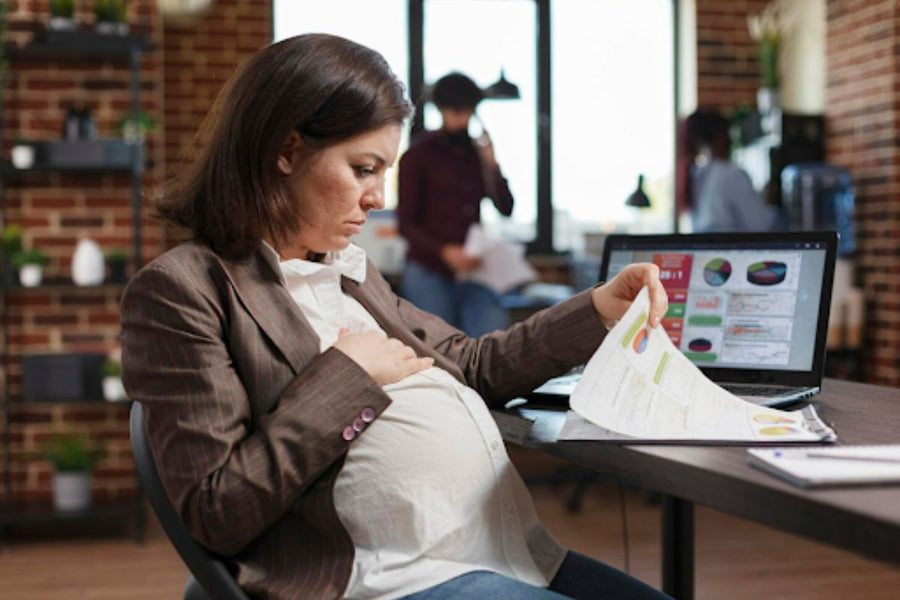Like it or not, exercise is one of those things that is so good for us that there is really no excuse not to do it. And that’s no less true during pregnancy. Whether you already have a regular exercise routine and are just seeking ways to modify it for pregnancy or want to start exercising for the first time as a way to stay as healthy as possible while you’re pregnant, there are a few things you should know that will help you stay safe and be effective. In this article, we cover the dos and don’ts of workouts for pregnant women as well as offer some options for good exercise for expecting mothers.
Why You Should Exercise During Pregnancy
If you’re not yet convinced you should even be exercising during your pregnancy at all, let us quell your hesitation. Sure, there may have once been a perception that pregnant woman shouldn’t do anything during their pregnancy other than kick back, relax, and gestate, but that’s no longer considered the best thing to do. In fact, the Journal of the American Medical Association highly recommends exercising while pregnant, whether or not you were doing so before your pregnancy began. Why? Well, among other things…
You’ll Feel Better
Sure, it may sound too good to be true, but exercising really does make you feel better, especially during so emotionally and physically volatile a time as pregnancy. Those endorphins will improve your mood, you’ll have more energy, and you’ll feel less stress. Plus, you’ll be less likely to develop anxiety and depression and you’ll even be able to sleep better at night.
It’s Good For Your Baby’s Health
Yep, you guessed it: exercising during pregnancy is one of the best things you can do to encourage your baby to develop healthfully. Specifically, it will make your baby more likely to be born at a normal, healthy weight, which in turn helps them develop into a healthy child and adult.
It’ll Make Your Pregnancy Easier
Getting in your regular exercise time during pregnancy won’t just make you feel good, it’ll also prevent you from feeling bad. Exercising while pregnant can reduce your risk of pregnancy complications such as pre-eclampsia and pregnancy-induced hypertension. It’ll also reduce back and pelvic pain and prevent or help manage urinary incontinence and constipation. Plus, it will improve your circulation, posture, and help prevent you from gaining too much weight.
It Will Make Your Delivery Easier
If you’re nervous about your delivery - which, let’s face it, who isn’t? - you might be happy to hear that you can make it easier on yourself by working out during your pregnancy. Not only will it prepare you for the physical demands of labour, but it will also help prevent delivery complications and allow you to heal faster afterwards. Exercising while pregnant is also known to reduce the likelihood of needing a C-section or an episiotomy.
You’ll Be Better Prepared for Motherhood
Whether or not you exercise and build up your muscles and endurance during your pregnancy, you’ll need to be strong when you become a mum. Working out can help prepare you for the physical demands of motherhood, like carrying a heavy baby all day (they don’t stay eight pounds for long!).
If all that sounds like something you want, you’d certainly be willing to do something as simple as getting twenty to thirty minutes of exercise a day to achieve it, right?
Safety Precautions for Working Out While Pregnant
Whether you’re adjusting an existing workout regimen or starting a new one, there are a few special considerations for pregnant women when it comes to exercise that you should know about.
First, it’s a very good idea to talk to your doctor and check in about any exercise you’re planning to do while pregnant. Naturally, they will know best what to recommend for you to try and/or to avoid.
Additionally, there are some other general safety tips that it are highly recommended you follow. These include:
- Drinking enough water before, during, and after exercise and avoiding overheating - especially during the first trimester.
- Avoiding holding your breath during strenuous activity, as it puts pressure on your pelvic floor. That makes your workouts a great time to practice that slow, steady breathing that will be so useful during delivery!
- After you hit 16 weeks, you’ll have to avoid any exercises that involve lying on your back, like crunches and certain stretches. That is because, at that point, your baby will be heavy enough to put pressure on your spine and vena cava blood veins (the ones that help get blood to your heart) in that position.
- Naturally, there are some high-intensity, high-impact, and high-risk activities that you’ll want to avoid during pregnancy, such as skating, contact sports, kickboxing, horseback riding, heavy weightlifting, softball, skiing, gymnastics, scuba diving, high-altitude training, and martial arts. A good rule of thumb is that you should cut out any activity that involves a risk of falling or being hit.
- Don’t push yourself too hard! Especially if you’re an avid exerciser already, you may like the feeling of pushing your body to the limit, but it’s important to be gentle with your pregnant body and respect your limits. When in doubt, err on the side of gentle and light exercise. Try to never exercise to the point that you are so out of breath you can’t talk.
Exercise for Pregnant Women
All of that being said, let’s get into what you should or can do for exercise when you’re pregnant. First, let’s start with some general guidelines.
- Try not to take on any new high-impact or high-intensity exercises during pregnancy. However, if you were already doing them before, you can continue up until the start of your second trimester.
- Focusing on strengthening your core muscles and pelvic floor will be a tremendous help in making pregnancy, delivery, and recovery easier for you, so don’t forget to include these exercises!
- Always remember to warm up before your workout and stretch after to loosen up your joints and ligaments and properly prepare for exercise.
- Know that even seemingly small things - like walking, household chores, and taking the stairs - do count as exercise.
- Some of the best exercise for pregnant women includes activities like early pregnancy yoga, swimming, cycling, jogging, pregnancy exercise classes, water aerobics, and resistance (strength) training.
- A good guideline is to try to get at least 150 minutes of moderate-intensity aerobic activity each week.
- Consider using a pregnancy support belt for extra stability and balance during exercises

First Trimester
Like we mentioned above, if you are already doing a regular exercise program, in all likelihood, you’ll be okay to continue it in your first trimester - though you should check with your doctor first to make sure. Just be sure to note that you may find your heart rate coming up faster than usual when you’re pregnant and taking longer to come back down.
If you haven’t already been exercising, consider starting with light, gentle activity like pregnancy yoga stretches, walking, swimming, and light abdominal and pelvic floor exercises.
Try to aim to get in at least 30 minutes of moderate aerobic activity on most days of the week, with strength training two to three times a week. Don’t forget that going on an easy afternoon walk totally counts!
This may also be a good time to check out some exercise classes for pregnant women - whether they be online or in person - to help you build a foundation of knowledge about posture and form that you’ll be able to draw on for the rest of your pregnancy and beyond.
Some great exercises to try during this time include pelvic curls, pelvic braces, kneeling push-ups, squats, bicep curls, triceps kickbacks, bird dogs, and (light) deadlifts.
Second Trimester
A lot of women report their second trimester as being the best they feel throughout their entire pregnancy, which can be great motivation to keep up an exercise routine! However, in your second trimester, you’ll need to start making some adaptations to your workout routine to accommodate for several things like your growing baby bump and changes in your centre of gravity.
In your second semester, you’ll need to try to avoid high-impact exercises such as jumping and running. You’ll also want to avoid spending too much time lying on your back and anything that throws your balance off or makes you overly exhausted.
If any of the exercises you were doing previously make you uncomfortable, that can be a sign to stop doing them or to modify by doing them with lighter weights or for shorter sessions. And of course, don’t stop doing your abdominal and pelvic floor exercises, which may even be easier now after you’ve built a foundation of strength and form during your first trimester.
Third Trimester
In your third and final trimester, you’ll most likely notice your body slowing down as it prepares to give birth. But you won’t want to stop exercising, as keeping up your strength and endurance during this time is as important as ever. That being said, at this point, gentle exercises are best. That includes things like walking, swimming, prenatal yoga, and bodyweight strength exercises.
More than ever, the third trimester is an important time to avoid any exercises that include impact or risk of impact to your abdomen, like that which can result from a fall. It may be a good idea to exercise seated or near a wall so that you can avoid losing your balance. To avoid pubic symphysis pain - a common problem - it’s a good idea not to do any exercises that involve spreading your legs too far apart from each other.
Diastasis Recti
One common occurrence during pregnancy is diastasis recti, which is when the abdomen muscles split apart from each other in the middle to make room for your baby. While this is totally normal, it can be challenging to recover from, so exercise is a great way to try and combat diastasis recti. You can check out some great diastasis recti correction exercises here. It’s a good idea to do these especially in your third trimester.
Warning Signs
If you experience any of the following symptoms because of exercising during pregnancy, it’s recommended that you stop exercising and see a doctor.
- Headache
- Dizziness or faintness
- Heart palpitations or chest pain
- Swelling in the face, hands, or feet
- Calf pain or calf swelling
- Vaginal bleeding or contractions
- Deep pain in the back, pubic, or pelvic area
- Cramping in the lower abdomen
- Difficulty walking
- Leakage of amniotic fluid
- Unusual shortness of breath
- Excessive fatigue or muscle weakness
But don’t worry, exercising while pregnant is perfectly safe. As long as you listen to your body and follow the precautions mentioned above, you’ll most likely be completely fine - and better!
And remember, any exercise is better than none, so it’s okay if you don’t start an intense new exercise routine during pregnancy. This isn’t the time to become a professional athlete. Rather, it’s all about focusing on taking care of yourself and your body and helping to ensure the health of both you and your baby.


